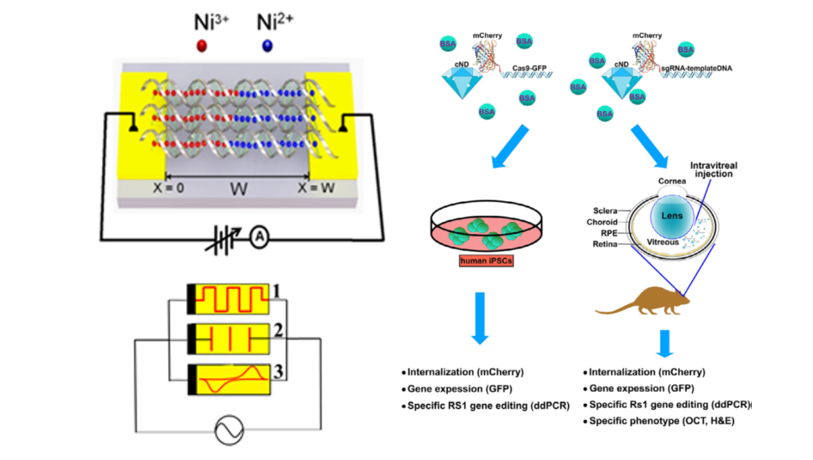Video Article Open Access
Functional Nano/Biomaterials Development for Nanoelectronics and Biomedicine Application
Chia-Ching Chang1,2,3
1Department of Biological Science and Technology, National Yang Ming Chiao Tung University, Hsinchu 30068, Taiwan
2Department of Electrophysics, National Yang Ming Chiao Tung University, Hsinchu 30010, Taiwan
3Institute of Physics, Academia Sinica, Nankang, Taipei 11529, Taiwan
Vid. Proc. Adv. Mater., Volume 3, Article ID 2210354 (2022)
DOI: 10.5185/vpoam.2022.10354
Publication Date (Web): 23 May 2023
Copyright © IAAM
Graphical Abstract

Abstract
DNA is a nanowire in nature. However, poor conductivity blocks the application in nano-electronics. By denaturing the DNA and letting nickel ions chelated into the DNA molecule, a micrometer in length conducting nanowire, Ni-DNA, has been developed. Ni-DNA devices possessed room temperature negative resistance (NDR) behavior, memristor, and memcapacitor property which can be used for multi-stages switching, or memory. This is the first biomaterials nano-memdevice in the world. In spite of nanoelectronics application, functional DNA, CRISPR/ Cas 9 system, and fluorescence tracible carboxylated nanodiamond (cND) has been integrated and a high transfection efficiency gene editing system has been developed. Therefore, the cND as the carriers of CRISPR/Cas9 components are designed to introduce the mutation in the RS1 gene associated with X-linked retinoschisis (XLRS). The transfection efficiency is 10 folds higher than conventional approaches. RS1 gene editing in mouse retinas resulted in several pathological features can be observed. Our ND-based CRISPR/Cas9 delivery system can be utilized as a tool for creating in vitro and in vivo disease models of XLRS.
Keywords
Ni-DNA; fluorescence tracible carboxylated nanodiamond; genome editing; CRISPR/ Cas 9 system; X-linked retinoschisis (XLRS).
Acknowledgement
These studies are supported in part by the National Council of Science and Technology (NCST), Taiwan (ROC) MOST 107-2112-M-009-016-MY3, MOST 108-2314-B-006-009-MY3, MOST 109-2327-B-010-005, MOST 109-2327-B-009-001, MOST 109-2927-I-009-003, MOST 111-2112-M-A49-025. These works are also supported by the Ministry of Education through the SPROUT Project and the Center for Intelligent Drug Systems and Smart Biodevices (IDS2B) of NYCU, Taiwan.
References
- Yang T.C., et al., Acta Biomaterialia, 2020, 101, 484.
- Chang P.C., Chang C.Y., Jian W.B., Yuan C.J., Chen Y.C., Chang C.C., Nano Research, 2019, 12, SI, 1293.
- Chu H.L., Lai J.J., Wu L.Y., Chang S.L., Liu C.M., Jian W.B., Chen Y.C., Yuan C.J., Wu T.S., Soo Y.L, Di Ventra M., Chang C.C., NPG Asia Materials, 2017, 9, e430.
- Chu, H.L., Chiu, S.C., Sung, C.F., Tseng, W., Chang, Y.C., Jian, W.B., Chen, Y.C., Yuan, C.J., Li, H.Y., Gu, F., Di Ventra, M.; Chang, C.C., Nano Letters, 2014, 14, 1026-1031.
Biography
Chia-Ching Chang is a Biological Physicist who is specialized in new functional biomaterials design and synthesis, as well as their bio-nanotechnology application. He is currently a Professor in the Department of Biological Science and Technology, National Yang Ming University (NYCU). At the same time, Dr. Chang is also an adjunct Professor in Department of Electrophysics, NYCU and Research Fellow of the Institute of Physics, Academia Sinica, Taiwan. Dr. Chang has successfully developed first Ni-DNA-based room temperature NDR, memristor/memcapcitor devices in the world. Moreover, Dr. Chang has proposed a first-order-like phase transition model which is combining biomolecules self-assembly and self-organization processes, both DNA and proteins can be restored into their functional state for bioelectronics, drug delivery and gene editing applications. Meanwhile, his study for SARS CoV-2 detection also has been cited by the WHO delegation for the investigation of the origin of COVID 19 in Nature, 2021. Based on these achievements, Dr. Chang has received FutureTech Award of Ministry of Science and Technology, Taiwan in 2021. Dr. Chang has received IAAM Scientist Award, 2022, recently. Google scholar: h-index: 22.
Video Proceedings of Advanced Materials

Upcoming Congress



